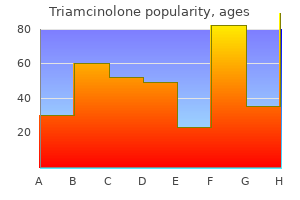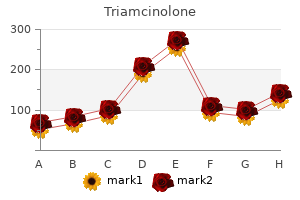"Buy triamcinolone 4 mg with visa, symptoms 2 weeks after conception".
By: Z. Armon, M.A., Ph.D.
Co-Director, UCSF School of Medicine
During the past 60 years psychiatric treatment has witnessed major changes due to advent of drugs which can have specific salutary effect in mental illnesses symptoms neck pain generic triamcinolone 4 mg without prescription. The trend has turned from custodial care towards restoring the individual patient to his place in the community medications similar to gabapentin order triamcinolone in india. All that could be done before 1952 was to dope and quieten agitated and violent patients medicine nausea order triamcinolone. Though it is a powerful pharmacological tool to study monoaminergic systems in brain and periphery symptoms type 1 diabetes buy triamcinolone with paypal, its clinical use in psychiatry lasted only few years. Meprobamate (1954) aroused the hope that anxiety could be tackled without producing marked sedation. This goal has been realised more completely by the development of Chlordiazepoxide (1957) and other benzodiazepines in the 1960s. Interestingly some antiepileptics like carbamazepine, valproate and lamotrigine as well as some atypical antipsychotics, etc. Nevertheless, broad divisions have to be made, primarily on the basis of predominant manifestations, to guide the use of drugs. It is important to make an attempt to characterise the primary abnormality, because specific drugs are now available for most categories. Principal types are: Psychoses these are severe psychiatric illness with serious distortion of thought, behaviour, capacity to recognise reality and of perception (delusions and hallucinations). There is inexplicable misperception and misevaluation; the patient is unable to meet the ordinary demands of life. Prominent features are confusion, disorientation, defective memory, disorganized thought and behaviour. A common form of mood disorder is bipolar disorder with cyclically alternating manic and depressive phases. The relapsing mood disorder may also be unipolar (mania or depression) with waxing and waning course. Neuroses these are less serious; ability to comprehend reality is not lost, though the patient may undergo extreme suffering. Depending on the predominant feature, it may be labelled as: (a) Anxiety An unpleasant emotional state associated with uneasiness, worry, tension and concern for the future. However, it has been interpreted differently by different people; some extend it to cover both chlorpromazine-like and antianxiety drugs, others feel that it should be restricted to the antianxiety drugs only. Phenothiazines Aliphatic side chain: Chlorpromazine Triflupromazine Piperidine side chain: Thioridazine Piperazine side chain: Trifluoperazine Fluphenazine Butyrophenones Haloperidol Trifluperidol Penfluridol Thioxanthenes Flupenthixol Other heterocyclics Pimozide, Loxapine Atypical antipsychotics Clozapine Aripiprazole Risperidone Ziprasidone Olanzapine Amisulpiride Quetiapine Zotepine Pathophysiology of mental illness is not clear, though some ideas have been formed. Antipsychotic (neuroleptic, ataractic, major tranquillizer) useful in all types of functional psychosis, especially schizophrenia. Antimanic (mood stabiliser) used to control mania and to break into cyclic affective disorders. Antidepressants used for minor as well as major depressive illness, phobic states, obsessive-compulsive behaviour, and certain anxiety disorders. Antianxiety (anxiolytic-sedative, minor tranquillizer) used for anxiety and phobic states. Spontaneous movements are minimized but slurring of speech, ataxia or motor incoordination does not occur. All phenothiazines, thioxanthenes and butyrophenones have the same antipsychotic efficacy, but potency differs in terms of equieffective doses. The sedative effect is produced promptly, while antipsychotic effect takes weeks to develop. Performance and intelligence are relatively unaffected, but vigilance is impaired.
Syndromes
- Increase in blood sugar levals (diabetes)
- Pain may move to groin area (groin pain) or testicles (testicle pain).
- Endoscopic ultrasound
- Serum magnesium
- Retinitis pigmentosa
- 25% chance of a boy with disease
- Drugs that mimic the activity of your nervous system
- Did this occur after you had anesthesia?

The in vitro component of the sugarcane transformation process has the potential to generate somaclonal variation to the regenerated plants medications hyponatremia order triamcinolone 4 mg, and selection by antibiotics or herbicides can add to this increased polymorphism (Carmona et al medicines 604 billion memory miracle discount triamcinolone online mastercard. However symptoms you have cancer buy triamcinolone with a mastercard, as discussed below symptoms 3 weeks pregnant triamcinolone 4 mg amex, the effect may be epigenetic and, in addition, plants exhibiting tissue-culture-derived somaclonal variation are systematically culled during micropropagation-based seedling production systems. These are expressed mainly in callus and may be the cause of the observed high somaclonal variation in this tissue (de Araujo et al. Epigenetic effects may also account for observed unusual growth patterns; however, these are often temporary and are usually resolved within a few generations of vegetative reproduction (Birch, 1997; Taylor et al. Sugarcane has also been genetically engineered for the production of novel industrial compounds. Sugarcane is a C4 grass so it has a high growth rate and efficient carbon fixation. In addition to the C4 qualities, it has a substantial carbon flux through metabolic pathways, and the waste bagasse could be used to generate electricity needed for processing of the biofactory products (Twine, 2005). In Argentina, field trials have been performed with herbicide-tolerant and virus-resistant varieties (Raney and Matuschke, 2011). Sugarcane is a large tropical grass that produces multiple stems or culms, each of which consists of a series of nodes separated by internodes. Following germination (sprouting of sett), the terminal vegetative bud of each shoot lays down a series of nodes. Each node consists of a growth ring or intercalary meristem, the root band (containing root primordia) and a bud above the leaf scar where the leaf sheath attaches, which delimits the node from the internode below. The internodes consist of sucrose-storing parenchyma cells and vascular tissue (Moore, 1987). The stem of sugarcane is similar to maize (corn) and sorghum in that it is filled with parenchyma cells and is not hollow like many grasses (Griffee, 2000). The stem is the major storage area for photosynthate (sucrose) within the sugarcane plant, rather than fruit or seed structures. Transverse sections through an internode reveal vascular bundles surrounded by parenchyma cells with a thick outer epidermis covered in an external layer of wax. Leaves and internodes develop in a basipetal direction in that the leaf blade expands at the base then the internode elongates. At the top of the stem is an apical meristem set on top of a number of very short internodes. Mature stems consist of a number of immature leaves still enclosed in the leaf spindle, a dozen or so green leaves and a number of senescent leaves, increasing in number with increasing age of the plant. Leaves may be retained on the stem or they may be shed in some varieties, known as free-trashing. Internode length can reach over 30 cm, depending on growth conditions, and stems normally reach 2-3 metres in the normal growing season (Bull, 2000; Bull and Glasziou, 1979). The leaf blade is pubescent (hairy) on the abaxial (under) side of the leaf and glabrous (without hairs) on the adaxial (top) side and terminates in a pointed tip. The base of the leaf blade is attached to the leaf sheath that encloses the internode, joining the stem at the node to which the leaf subtends. The anatomy of the leaves reflects this underlying physiology; the vascular bundles are surrounded by a ring of bundle sheath cells and a ring of mesophyll cells, an arrangement known as Kranz anatomy. It has been estimated that the top 25 cm of soil contains 50% of the plant roots, with the next 35 cm containing a further 40% of the roots (Fauconnier, 1993). The root system is dynamic and the area of active root growth varies depending on the irrigation pattern (Inman-Bamber et al. The plant also develops buttress roots that serve to anchor the plant, and some deeply penetrating roots that grow downwards for up to four metres allowing for water absorption under water stress (Bull and Glasziou, 1979). Roots partially die-back after ratooning, although there is evidence that some roots can persist for at least four months after harvest and some of the new roots emerge from the old preharvest roots (Smith, Inman-Bamber and Thorburn, 2005). Reproductive morphology the sugarcane inflorescence is an open branched panicle (a compound raceme), also known as an arrow, whose shape, degree of branching and size are highly cultivar specific (Figure 2. The arrow can bear thousands of flowers (Sleper and Poehlman, 2006), and is estimated to average 24 600 florets (Rao, 1980).
Purchase triamcinolone visa. Marijuana for Benzodiazepine Withdrawal Symptoms?.

The subsequent events are common in the two systems and result in polymerization of fibrinogen to form fibrin strands medications 2 times a day discount generic triamcinolone uk. On the other hand treatment brachioradial pruritus buy discount triamcinolone 4mg on-line, factors like antithrombin symptoms als cheap generic triamcinolone uk, protein C medicine 123 order triamcinolone 4mg with amex, protein S, antithromboplastin and the fibrinolysin system tend to oppose coagulation and lyse formed clot. Thus, a check and balance system operates to maintain blood in a fluid state while in circulation and allows rapid haemostasis following injury. Fresh whole blood or plasma provide all the factors needed for coagulation and are the best therapy for deficiency of any clotting factor; also they act immediately. Vitamin K K1 (from plants,: Phytonadione fat-soluble) (Phylloquinone) K3 (synthetic) -Fat-soluble: Menadione, Acetomenaphthone -Water-soluble: Menadione sod. Most clotting factors are proteins present in plasma in the inactive (zymogen) form. By partial proteolysis they themselves become an active protease and activate the next factor. In addition to its critical role in cleaving and polymerizing fibrinogen, thrombin activates many upstream factors (especially f. K dependent factors have been encircled, Factors inactivated by heparin (H) in red; the more important inhibited steps are highlighted by thick arrow. This was later found to be due to decreased concentration of prothrombin in blood and that it could be cured by a fat soluble fraction of hog liver. This factor was called Koagulations vitamin (vit K) and soon its structure was worked out. A similar vitamin was isolated in 1939 from alfalfa grass and labelled vit K1, while that from sardine (sea fish) meal was labelled K2. Daily requirement It is uncertain, because a variable amount of menaquinone (vit K2) produced by colonic bacteria becomes available. Chemistry and source Vit K has a basic naphthoquinone structure, with or without a side chain (R) at position 3. The vit K dependent change (carboxylation of glutamate residues of these zymogen proteins; see. An active transport process in the jejunum has been demonstrated for K1, while K2 and K3 are absorbed by simple diffusion. Vit K is only temporarily concentrated in liver, but there are no significant stores in the body. It is metabolized in liver by side chain cleavage and glucuronide conjugation; metabolites are excreted in bile and urine. Deficiency Deficiency of vit K occurs due to liver disease, obstructive jaundice, malabsorption, long-term antimicrobial therapy which alters intestinal flora. The most important manifestation is bleeding tendency due to lowering of the levels of prothrombin and other clotting factors in blood. Because of hepatocellular damage, synthesis of clotting factors is inadequate despite the presence of vit K. However, vit K may be of some use if its absorption had been affected due to lack of bile salts. The cause is both lower capacity to synthesize clotting factors as well as deficiency of vit K. Haemorrhagic disease of the newborn can be effectively prevented/treated by such medication. Unnecessary high dose is to be avoided because it will render the patient unresponsive to oral anticoagulants for several days. Menadione and its water-soluble derivatives can cause haemolysis in a dose-dependent manner. In the newborn menadione or its salts can precipitate kernicterus: (a) by inducing haemolysis and increasing bilirubin load.
Diseases
- Achondrogenesis type 2
- Mastoiditis
- Juvenile hyaline fibromatosis
- Liver neoplasms
- Charcot Marie Tooth disease type 2C
- Fragile X syndrome type 2


